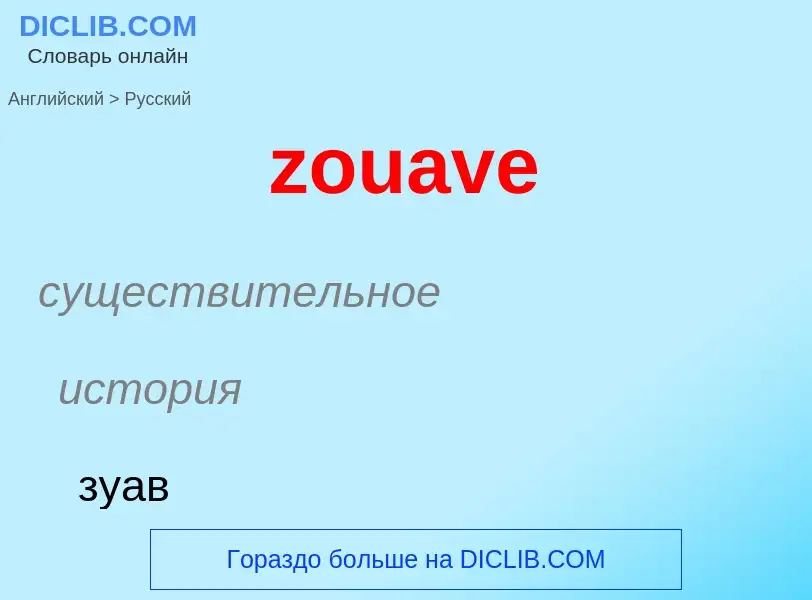Tradução e análise de palavras por inteligência artificial ChatGPT
Nesta página você pode obter uma análise detalhada de uma palavra ou frase, produzida usando a melhor tecnologia de inteligência artificial até o momento:
- como a palavra é usada
- frequência de uso
- é usado com mais frequência na fala oral ou escrita
- opções de tradução de palavras
- exemplos de uso (várias frases com tradução)
- etimologia
Zouave - tradução para russo
существительное
история
зуав
[zu:'ɑ:vzwɑ:v]
существительное
общая лексика
женский короткий расшитый жакет
история
зуав
Смотрите также
Definição
Wikipédia

The Zouaves were a class of light infantry regiments of the French Army serving between 1830 and 1962 and linked to French North Africa; as well as some units of other countries modelled upon them. The zouaves were among the most decorated units of the French Army.
It was initially intended that the zouaves would be a regiment of Berber volunteers from the Zwawa group of tribes in Algeria ("Zwawa" being the origin of the French term zouave) who had gained a martial reputation fighting for local rulers under the Ottoman Empire. The regiment was to consist of 1,600 Zwawa Berbers, French non-commissioned officers and French officers. 500 Zwawa were recruited in August and September 1830. However, twelve years later, this idea was dropped. More zouave regiments were raised and the men recruited to serve in them were almost exclusively French or people of French descent born in French Algeria (pied-noirs), a policy which continued until the final dissolution of said regiments after the Algerian War.
In the 1860s, zouave units arose in many other countries. The Papal Zouaves were organized by Louis Juchault de Lamoricière, a former commander of North African zouaves, while a former zouave sergeant, François Rochebrune, organized the Polish Zouaves of Death who fought against Russia in the January Uprising of 1863–1864. In the 1870s, former Papal Zouaves formed the cadre for a short-lived Spanish zouave unit. The "zouave" title was also used by Brazilian units of black volunteers in the Paraguayan War, possibly due to a perceived link with Africa.
In the United States, zouaves were brought to public attention by Elmer E. Ellsworth, who created and ran a drill company called the "Zouave Cadets". The drill company toured nationally. Zouave units were then raised on both sides of the American Civil War of 1861–1865; including a regiment under Ellsworth's command, the 11th New York Infantry—the New York "Fire Zouaves".
The distinctive uniforms of French and other zouave units was of North African origin. It generally included short open-fronted jackets, baggy trousers (serouel), sashes, and a fez-like chéchia head-dress.


![[[Zouaves of Death]] in the [[Battle of Miechów]] during the [[January Uprising]] of 1863; painting by [[Walery Eljasz-Radzikowski]] [[Zouaves of Death]] in the [[Battle of Miechów]] during the [[January Uprising]] of 1863; painting by [[Walery Eljasz-Radzikowski]]](https://commons.wikimedia.org/wiki/Special:FilePath/Battle of Miechów 1863.png?width=200)



![Conquest of Algeria]] Conquest of Algeria]]](https://commons.wikimedia.org/wiki/Special:FilePath/Prise de la Zaatcha (1849).png?width=200)
![French zouaves during the [[Crimean War]]; painting by [[Aleksander Raczyński]] (1858) French zouaves during the [[Crimean War]]; painting by [[Aleksander Raczyński]] (1858)](https://commons.wikimedia.org/wiki/Special:FilePath/RaczynskiAleksander.ZuawiWWalce.1858.jpg?width=200)
![A group of four zouaves of the French Army pose for the camera during the [[Crimean War]], 1854–1856. A group of four zouaves of the French Army pose for the camera during the [[Crimean War]], 1854–1856.](https://commons.wikimedia.org/wiki/Special:FilePath/The Crimean War, 1854 - 1856 Q71609.jpg?width=200)

![''[[The Brierwood Pipe]]'', an 1864 oil painting by [[Winslow Homer]] of two 5th New York Zouaves ''[[The Brierwood Pipe]]'', an 1864 oil painting by [[Winslow Homer]] of two 5th New York Zouaves](https://commons.wikimedia.org/wiki/Special:FilePath/Winslow Homer - The Brierwood Pipe.jpg?width=200)
![Jules Marie Deluen (1849–1918) in [[Papal Zouave]] uniform in Nantes, France Jules Marie Deluen (1849–1918) in [[Papal Zouave]] uniform in Nantes, France](https://commons.wikimedia.org/wiki/Special:FilePath/Zouave Pontifical.jpg?width=200)
![Guard Zouaves (''Zouaves de la Garde'') during the [[Second Italian War of Independence]] in 1859. Guard Zouaves (''Zouaves de la Garde'') during the [[Second Italian War of Independence]] in 1859.](https://commons.wikimedia.org/wiki/Special:FilePath/Zouaves de la Garde pendant la campagne d'Italie.jpg?width=200)

